Although built as an art piece, Nicolas Schöffer's CYSP-1 (a name composed of the first letters of CYbernetics and SPatiodynamic) is significant both in terms of the introduction of a new art form, as well as being a serious attempt as an autonomous "being". Schöffer was the first artist to be inspired by the new science of Cybernetics, and went so far as to describe a whole cybernetic city based on his so-called "Spatio-Dynamics".
Before showing some early articles about CYSP-1, I want to briefly describe the functions it performs. To put it into context, given the usage of "electronic brains" that prevail in the articles, I thought I would give the components of "electronic brains" as they were thought of at the time (i. e. mid 1950's).
Essentially they are: SENSORY ORGAN -> NERVE SYSTEM -> BRAIN -> MUSCLES
One expects Schöffer’s CYSP-1 to conform to this early definition of "electronic brain".
Philips were sponsors for CYSP-1 and the earlier "Spatio-dynamic tower". One of the articles in the book "Nicolas Schöffer" describes the "homeostatic" electronic brain used in tha tower sculpture. Based on the descriptions on CYSP-1's behaviour, it, too, appears to be modelled on the homeostat. The homeostat, as first described and modelled by Ashby, essentially seeks an equilibrium point when it gets out of balance. CYSP-1 is a homeostat on wheels.
For completeness, I'll make the "Spatio-dynamic tower" homeostat comparison with CYSP-1 here:
From an article in the book "Nicolas Schöffer":
" a homeostat constantly seeks to establish a balance which is perpetually disrupted, and performs a statistical exploration of all the possible combinations of inputs.
The actual research on the apparatus is guided by a triple determinism which integrates:
1. one element of uncertainty created by an "indifferent cell," which systematically makes use of chance;
2. one element of "sensorial reactions" which integrates the effects of the sound atmosphere, of the light atmosphere and of the heat atmosphere;
3. an "internal determinism" created by the feedbacks of the various active chains among one another, in order to liberate the machine progressively. Its degree of liberty can easily be modified.
The objective sought is above all of an experimental order. As for electronic animals, the synthesis of the faculties must be effected very gradually, and the behavior of the "models" man makes of himself must be observed. This exploration by the "models" of physiology, psychology and sociology marks the opening of a new path in research."
In point 2, CYSP-1 is affected by sound intensity, by light intensity and heat (an interpretation of the colour of the light eg red=warm, blue=cold). Sound is detected by microphone input, and CYSP-1 reacts by being excited by silence and is calmed by noise. Photoelectric cells detecting colour are excited by the color blue, which means that it moves forward, retreats or makes a quick turn, and makes its plates turn fast; it becomes calm with red. It is also excited in the dark and becomes calm in intense light. CYSP-1 has total autonomy of movement (being travel in all directions at two speeds) as well as axial and eccentric rotation, and the setting setting in motion of its 16 pivoting polychromed plates (11 rectangular, 5 disc). This is the internal feedback talked about in point 3 above, and is the BRAIN, in this case a homeostatic one. "Liberating the machine" can be seen as a general reference to the MUSCLES in the "electronic brain" model above.
When used for dancing or outdoor movements, there was a radio remote control to ensure safety to nearby people and CYSP-1 itself. Later on, CYSP-1 is fitted with some photo-electric cell sensors underneath the base that detect dark and light. This way, if a dark line is drawn to create a closed space, CYSP-1 will not cross that line and keep its movements within that space. This is evident in the Paris Atelier today where CYSP-1 normally lives. (see pic below).
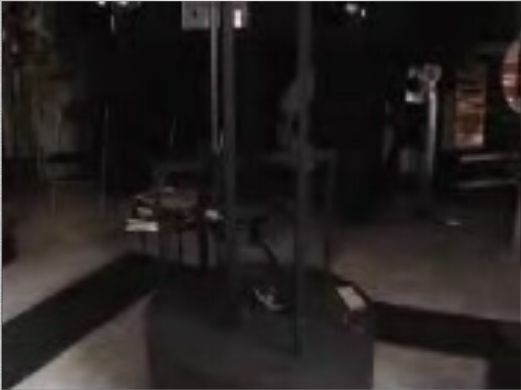
A point of interest I learned when talking with Eleanor (2009) is that Nicolas put in place a directive that in order to keep the sculptures operational over time, that the use of current technology be deployed, rather than conserving or restoring older technology that will prove difficult to service or get spare parts.
CYSP-1 is about 8 foot tall.
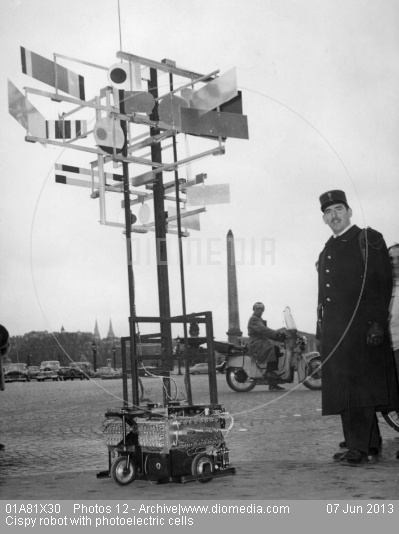
Flat batteries in December of 1956.
From “Practical Robot Circuits” A.H. Bruinsma – a Philips Technical publication
This extract is to provide the reader with a contextual and period definition of “electronic brain”. Large computers were very new and mini-computers were yet to be invented. These “electronic brains” are very different to modern digital computers.
"Robot circuits comprise certain elements which, although more highly developed or specialized in some circuits than in others, are nevertheless common to all of them, as follows (see fig. 1).
SENSORY ORGAN -> NERVE SYSTEM -> BRAIN -> MUSCLES
Fig. 1. Basic elements of a robot circuit.
1. sensory organ, that is, a portion of the circuit capable of picking up (or observing) different stimuli and converting them into electric current or voltage; accordingly, there are many different types of sensory organ;
2. nerve-system, that is, the portion of the circuit which modifies the current or voltage so that it may be applied to and used in:
3. the brain, or portion of the circuit sorting and processing the data from the nerve system, and possibly storing them (memory) before transmitting them to:
4. the muscles, or portion of the system producing the desired reaction to the stimuli picked up by the sensory organs.
With human beings and animals it is often difficult to discern where the nervous system ends and the brain begins; so also with many robot circuits.
It will be evident that the above names are chosen to emphasize the similarity between the synthetic elements referred to and living organs of the human body. Although there is nothing against this in theory, it will be seen later that in reality electronic organs often function very differently from the human or animal equivalents. At the same time it will also be seen that the temptation to draw a parallel between them, occasionally, has proved irresistible.
As we shall see, then, electronic sensory organs range from the rudimentary to the highly sensitive. They are sometimes inferior, sometimes equal, and in many cases superior, to human sensory organs.
Electronic nerve systems, although comparable in speed and accuracy to the human nerves as conveyors of information, cannot in any one machine equal them for complexity.
In the matter of brains, electronics is definitely outclassed. Electronic brains, without the gift of creative reasoning, are comparable only with the portion of the human brain governing reflexes, or actions performed instinctively, without thought.
Electronic memories, on the other hand, are best as regards reliability, being capable of storing up to ten thousands different items of information indefinitely; however, their capacity is very limited compared with the enormous variety of information assimilated by the human
brain.
Because this may suggest that on the whole electronic robots are barely on par with the lowest known species of animal, it should also be borne in mind that for practical applications they are so specialized for strictly limited tasks as to be, within the particular province, far superior to human operators; hence their importance to mankind.
It is typical of the world in which we live that everyone must specialize in order to be reasonably efficient, and electronic robots carry specialization far beyond what any man can hope to achieve."
CYSP 1, the first cybernetic sculpture
CYSP 1 (a name composed of the first letters of cybernetics and spatiodynamic) is the first " spatiodynamic sculpture " having total autonomy of movement (travel in all directions at two speeds) as well as axial and eccentric rotation (setting in motion of its 16 pivoting polychromed plates).
Nicolas Schöffer has executed this spatial composition in steel and duraluminum, into which an electronic brain, developed by the Philips Company, has been incorporated.
The whole is set on a base mounted on four rollers, which contains the mechanism and the electronic brain. The plates are operated by small motors located under their axis. Photoelectric cells and a microphone built into the whole catch all the variations in the fields of color, light intensity and sound intensity.
All these changes occasion reactions on the part of the sculpture consisting of combined travel and animation. For example: it is excited by the color blue, which means that it moves forward, retreats or makes a quick turn, and makes its plates turn fast; it becomes calm with red, but at the same time it is excited by silence and calmed by noise. It is also excited in the dark and becomes calm in intense light.
Inasmuch as these phenomena are constantly variable, the reactions are likewise ever changing and unpredictable, which endows the mechanism with an almost organic life and sensitivity.
Cybernetics
CYSP 1 launches upon an adventure unique in the history of art. It participates in artistic life on multiple levels.
In an actual spectacle, it dances in ballets with one or several human partners. It takes its place in motion pictures. An abstract film, for instance, is being planned, using all possible visual effects, such as the stroboscopic effect which occurs when its polychrome plates turn at the speed of light vibrations, giving an effect of immaterial colored blends; its shadow projected in movements gives the spectacle a double effect. Its transparency confers upon it multiple partially arrested aspects. It can adapt itself to the theater and participate in exhibitions.
It constitutes a living counterpoint, a new and harmonious contrast with the articulated movements of the undulating bodies of humans by its evolutions and its transparent, orthogonal and metallic structure.
This artificial being is the prototype of a whole series of other spatiodynamic sculptures which could stage a great cybernetic spectacle on the ground and even in the air, thus creating a true synthesis between the most advanced aesthetic conceptions and the most up-to-date scientific means, capable of multiplying their attractive possibilities tenfold.
The making of an animated spatiodynamic sculpture marks the first attempt at allying abstract sculpture and choreography. Both of these, reflecting as they do a comparable artistic expression, have been fused into a single object thanks to electronics and to cybernetics.
Maurice Bejart showed this robot-dancer for the first time in 1956 in a ballet performance. He executed with it a pas de deux to the accompaniment of a concrete music composition by Pierre Henry.
Spatiodynamic sculpture, for the first time, makes it possible to replace man with a work of abstract art, acting on its own initiative, which introduces into the show world a new being whose behavior and career are capable of ample developments.
Cysp 1, 1956, the first cybernetic sculpture with autonomous movements on the stage of the Sarah-Bernhardt Theater
and from the book “Nicolas Schöffer” – Essay “From Space to Time” by Guy Habasque.
This excursion into the realm of electronics made Schöffer even bolder and gave him the idea of resorting to cybernetics to animate his sculptures. The dynamism he had achieved, interesting though it was, had thus far remained what I have elsewhere called a " static dynamism " (dynamis, in fact, means power and not movement). It is true that he had already tried, in 1950, in a " spatiodynamic clock ", to introduce real movement by supplying the sculpture with little electric motors, but cybernetics opened up to him a much vaster field of action, and even made available to him combinations of movements in practically unlimited numbers. Above all it introduced a real element of indetermination in the kinetic behavior of the work. After a good deal of difficult research, and very delicate developing and perfecting (carried out in collaboration with Francois Terny, an engineer of the Philips Company), Schöffer, on May 28, 1956, on the occasion of the " Night of Poetry " in the Sarah Bernhardt Theater in Paris, presented his first "cybernetic sculpture ", CYSP I, the name of which is formed by the first two letters of the words " cybernetics " and " spatiodynamics " respectively. This mechanism, capable of articulated movements and locomotion without the direct help of a human agent, seemed endowed with an almost organic sensitivity. I say " seemed ", for it is quite obvious that no sculpture can be compared to a living being. Nevertheless, as anyone knows who has studied cybernetics a little, once the machine has been fed " information ", it acquires real autonomy of action. Provided with an electronic brain (concealed in its base), acting on a system of motor organs, CYSP I moves at two different speeds while putting into motion its sixteen pivoting polychrome plates. By virtue of a system of photoelectric cells and microphones, it is sensitive to all variations occurring in the realms of color, light intensity and sound intensity. A blue light, for example, emitted by a projector, produces a rapid movement, whereas a red light calms it and causes its movements to slow down. Likewise, it is excited by silence or darkness and calmed by noise or a bright light.
Despite the outcries of old-fashioned aestheticians who are always afraid of not finding the creator revealed in his work, the application of cybernetics opens immense horizons to the plastic arts. The possibility of animating space in an entirely new way is indeed coupled with the introduction of a temporal element which had never been taken into account in the conception of a work of art. Space and time are henceforth indissolubly linked. Moreover, the work of art is no longer an inanimate object, which can be taken in at a glance, but constitutes of itself a whole spectacle. This aspect has led Schöffer to stress what might be called the " theatrical " possibilities of these sculptures and to have CYSP I participate in certain shows, in particular in choreographic shows. Thus Maurice Bejart, who was then the director of the " Ballets de l'Etoile ", composed specially for it a ballet which was first shown in August 1956 at the first Festival of Avant-Garde Art in Marseille, on the roof of Le Corbusier's famous housing unit. He used the sculpture in conjunction with human partners, the flexibility and grace of the dancers creating a very striking and effective contrast with the rigid and orthogonal lines of the spatiodynamic skeleton, Pursuing his research, as always, to its ultimate consequences, Schöffer a little later conceived and executed the model of a theater specially designed for "cybernetic spectacles ", and for a long time he has even been entertaining plans for aerial spatiodynamic ballets. The theater is roofed over with a flattened semispherical dome beneath which the tiers of seats for the spectators rotate round an axis, while the ring- shaped stage also rotates, but in the opposite direction, round the center. In contrast to the customary arrangement the spectacle (cybernetic and human ballets, luminodynamic projections, etc.) consequently unfolds on the walls, and the audience also moves to follow the various elements that compose it. In the aerial ballets, space itself will serve as the stage, with the sculptures in movement evolving in the air, like helicopters.
Note on the homeostat produced by the Philips Company for the International Building and Public Works Exhibition, Paris 1955
An electronic brain is being built which will associate notes so as to compose constantly varying musical motifs. This will be effected by means of a homeostat which constantly seeks to establish a balance which is perpetually disrupted, and performs a statistical exploration of all the possible combinations of notes.
The actual research on the apparatus is guided by a triple determinism which integrates:
1. one element of uncertainty created by an " indifferent cell, " which systematically makes use of chance;
2. one element of " sensorial reactions " which integrates the effects of the sound atmosphere, of the light atmosphere and of the heat atmosphere;
3. an "internal determinism" created by the feedbacks of the various active chains among one another, in order to liberate the machine progressively. Its degree of liberty can easily be modified.
The objective sought is above all of an experimental order. As for electronic animals, the synthesis of the faculties must be effected very gradually, and the behavior of the " models " man makes of himself must be observed. This exploration by the " models " of physiology, psychology and sociology marks the opening of a new path in research.
Secondarily, the machine will produce anharmonic musical motifs, many of which will be of no great interest and will constitute a background of sound, while others will appeal to the ear. The sound material, pre-recorded by Pierre Henry, the composer of concrete music, author of the Voile d'Orphée (The Veil of Orpheus), will always be interesting and rich.
The sounds heard do not exist in nature any more than the associations of sounds invented by the machine are referable to our consciousness of harmony.
J. BUREAU Consulting engineer

from the French science magazine Science et Vie, September 1956
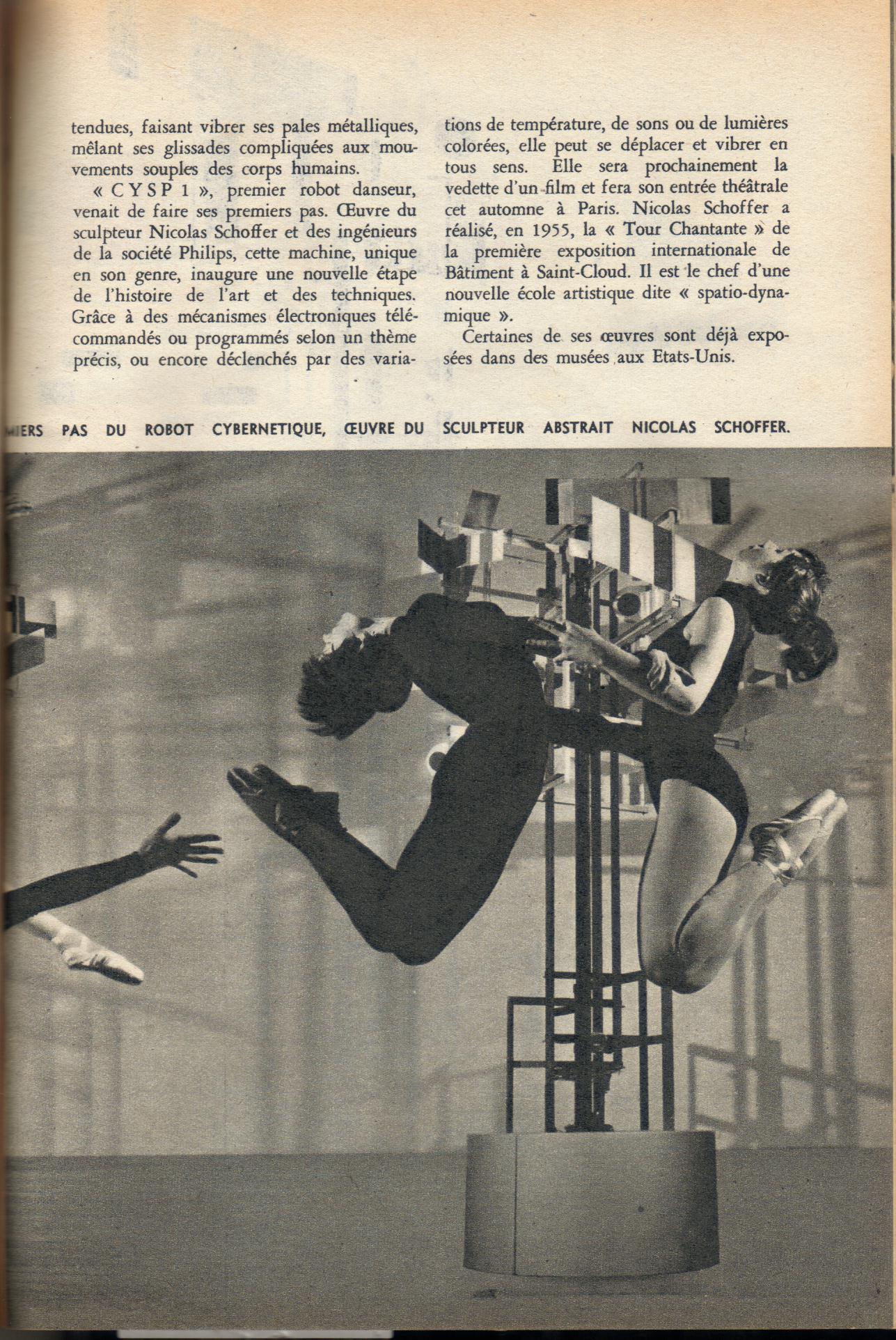
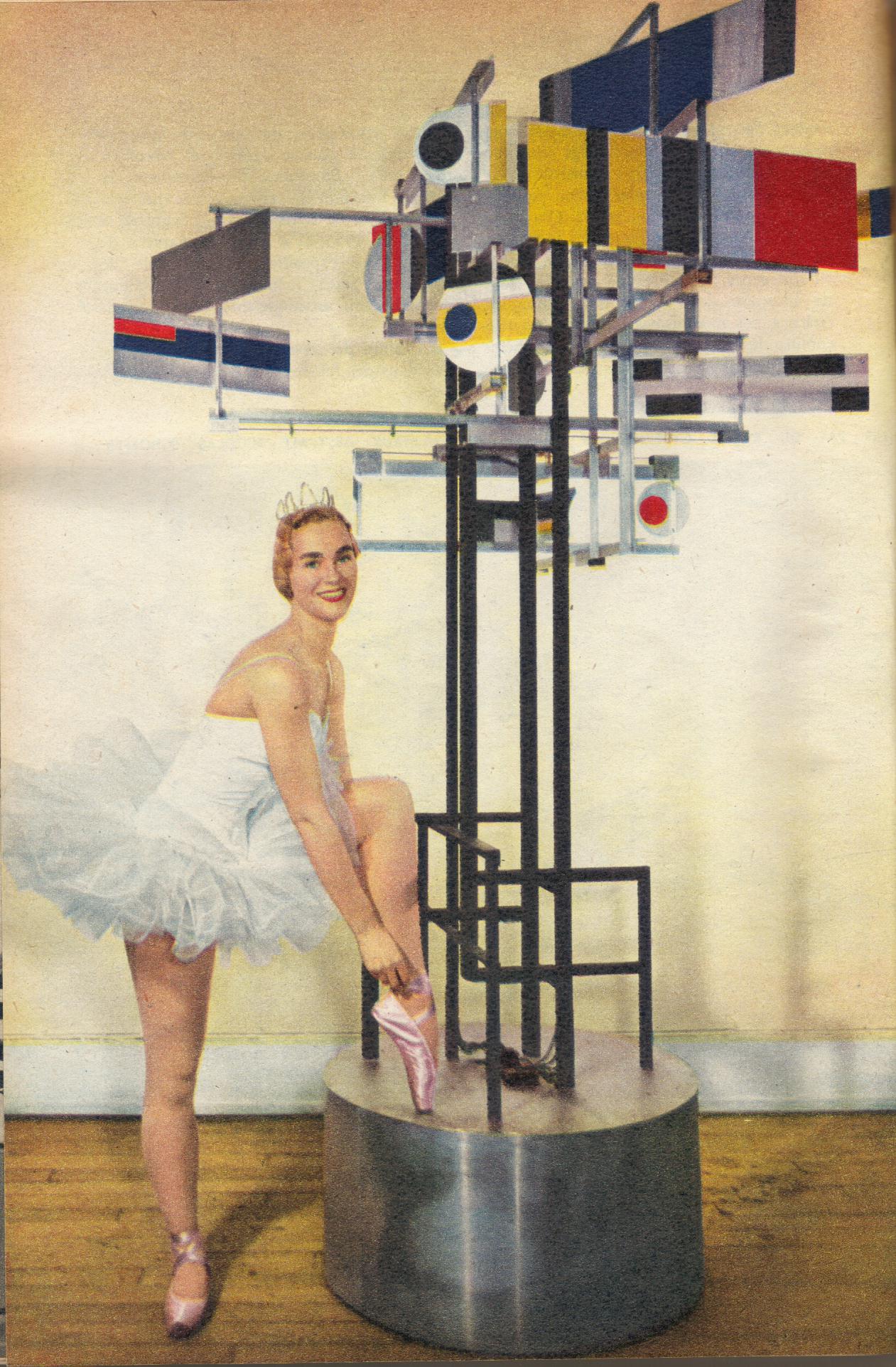

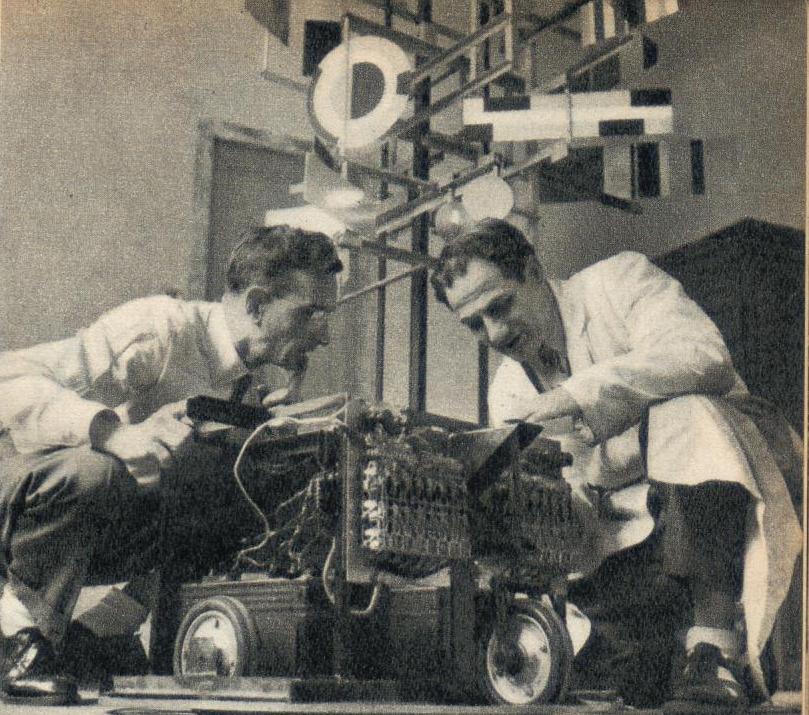
“CYSP 1”
danseuse-étoile est un robot
Un étrange spectacle nocturne s'est déroulé le 8 août à Marseille sur l'immense terrasse qui coiffe l'immeuble Le Corbusier. Pendant que des danseuses évoluaient gracieusement devant une sculpture abstraite faite de cornières d'acier et de feuilles de cuivre, un projecteur rouge s’alluma soudain. Les sons bizarres d'une musique concrète retentirent et, telle la statue du Commandeur, la sculpture s'anima brusquement. Elle entra dans la danse,
avantant et reculant sur des cadences inattendues, faisant vibrer ses pales métalliques, mêlant ses glissades compliquées aux mouvements souples des corps humains.
« CYSP 1 », premier robot danseur, venait de faire ses premiers pas. OEuvre du sculpteur Nicolas Schöffer et des ingénieurs de la société Philips, cette machine, unique en son genre, inaugure une nouvelle étape de l'histoire de l'art et des techniques. Grâce à des mécanismes électroniques télécommandés ou programmés selon un thème précis, ou encore déclenchés par des variations de température, de sons ou de lumières colorées, elle peut se déplacer et vibrer en tous sens. Elle sera prochainement la vedette d'un-film et fera son entrée théâtrale cet automne à Paris. Nicolas Schöffer a réalisé, en 1955, la « Tour Chantante » de la première exposition internationale de Bâtiment à Saint-Cloud. Il est le chef d'une nouvelle école artistique dite « spatio-dynamique ».
Certaines de ses oeuvres sont déjà exposées dans des musées ,aux Etats-Unis.
CAPTION :
SUR LA SCENE DU THEATRE SARAH-BERNHARDT, A PARIS, DES DANSEUSES REGLENT LES PREMIERS
PAS DU ROBOT CYBERNETIQUE, ŒUVRE DU SCULPTEUR ABSTRAIT NICOLAS Schöffer.CAPTION:
Au pied du robot, la danseuse Claude Bessy et deux ingénieurs de la Société Philips (à droite). L'ensemble de « CYSP 1 » est fixé sur un socle monté avec 4 roulettes mues par des moteurs électriques commandés par un cerveau électronique. Des cellules photoélectriques et des microphones captent des messages programmés sur un pas de danse : chaque plaque colorée des bras de la machine se met alors à vibrer et à tournoyer sur des rythmes différents combinés avec les déplacements du robot et ceux des danseurs.Cet être artificiel, campé sur les roulettes de caoutchouc de son cerveau électronique, est, selon les projets de Nicolas Schöffer, le prototype de toute une série de sculptures animées « spatio-dynamiques » qui seront les vedettes de grands spectacles cybernétiques. Des fusées, des avions, des hélicoptères, de la brume artificielle colorée, des projections lumineuses dans l'espace compléteront les entrechats mécaniques de ce peuple de robots dont les ombres en mouvement doubleront le spectacle.
Nicolas Schöffer prévoit aussi l'adjonction d'un homéostat à ses sculptures-robots : mouvements d'ensemble, variations isolées seraient déclenchées par la modification du milieu ambiant : température, hygrométrie, lumière du jour, sons et couleurs.
Grâce à cette animation, proche de certaines formes de vie organique, les sculptures spatio-dynamiques ne resteraient pas cantonnées sur la scène des théâtres ; exposées au regard des passants dans les grandes artères des grandes villes, elles constitueraient un spectacle permanent « son-lumière et animation » et permettraient aux citadins d'échapper parfois au sentiment de claustration provoqué par la laideur de certains quartiers d'habitation.
Ces sculptures, dignes de la science-fiction, rempliraient un rôle analogue, non seulement dans les pièces importantes des habitations, mais aussi dans les halls et dans les salles des grands bâtiments publics, les usines, les gares, les aérodromes, etc.
Sous cet aspect et, si l'on en croit les médecins et sociologues penchés sur ce problème bizarre, les robots abstraits de Schöffer seraient à l'origine d'une nouvelle science : la plastico-sociologie.
Cette science étudierait les effets des formes architecturales mécaniques sur le comportement de l'homme. Elle tenterait d'améliorer la qualité esthétique de cet immense cinérama qu'est devenue la vie moderne tout au fond de notre rétine. Selon ses théoriciens, l'homme normalement constitué a besoin d'une ration quotidienne de chocs esthétiques optiques ou auditifs d'une qualité supérieure. Or, cela se vérifie surtout dans nos cités vétustes, il y a généralement insatisfaction aggravée par la mauvaise qualité des « chocs ». Ce véritable « attentat rétinien » provoque à la longue des troubles psychiques : par exemple un complexe d'infériorité, puisque nous devons subir « ce qui est ». Le rôle des sculpteurs spatio-dynamiques sera de transformer cette ambiance désastreuse grâce à des proportions harmonieuses et à des couleurs thérapeutiques dosées qui réaliseront un équilibre énergétique entre la nature et le milieu artificiel où vit l'homme moderne.
Gérard COTTIN
Photos Frasnay et E. B. Weil.Translation:
"CYSP 1"
star-dancer is a robot
A strange night show was held August 8 in Marseille on the huge terrace, which covers the building Le Corbusier. While dancers moving gracefully to an abstract sculpture made of angle steel and copper sheets, projector suddenly turns red. The sounds of a strange sound and musique concrete, like the statue of the Commendatore, the sculpture comes alive suddenly. She entered the dance,
front and back of unexpected cadences, its vibrating metal blades, combining its complicated movements glissades soft human bodies.
"CYSP 1", the first robot dancer, came to take its first steps. Work by the sculptor Nicolas Schöffer and engineers of Philips, this machine is unique in its kind, heralds a new stage in the history of art and technology. Through electronic mechanisms remotely or programmed in a specific theme, or triggered by changes in temperature, sound or light colored, it can move and vibrate in all directions. She will soon star in a film and theater will be introduced this fall in Paris. Nicolas Schöffer produced in 1955, the "Singing Tower" of the first International Exhibition Building in St. Cloud. He is the head of a new artistic school known as "spatio-dynamic".
Some of his works are exhibited in museums in the United States.CAPTION:
ON THE SCENE OF THE THEATER-SARAH BERNHARDT, PARIS, dancers GOVERN THE FIRST
NOT THE ROBOT CYBERNETICS, WORK OF NICOLAS Schöffer ABSTRACT SCULPTOR.CAPTION:
Robot at the foot of the dancer Claude Bessy and two engineers from the company Philips (right). The whole "CYSP 1" is set on a pedestal mounted with 4 wheels driven by electric motors controlled by an electronic brain. Photoelectric cells and microphones capture messages programmed on a dance step: each colored plate of the arms of the machine starts to vibrate and spin in different speeds combined with the movements of the robot and the dancers.This being artificial, camped on the rubber wheels of his mind, is, according to draft Schöffer Nicolas, the prototype of a series of animated sculptures "spatio-dynamic" to be the stars of big shows cyber. Rockets, planes, helicopters, fog artificial colored light projections in space complement entrechats mechanical robots that people whose shadows moving double the performance.
Nicolas Schöffer also adding a homeostatis his sculptures robots: motion picture, isolated changes be triggered by the change in ambient temperature, humidity, light, sounds and colors.
With this animation, close to some forms of organic life, sculptures spatiotemporal dynamics would not remain confined to the theater scene, set against the great passers in the streets of major cities, they constitute a permanent show "its light – and animation and allow the city to escape the feeling sometimes of confinement caused by the ugliness of some residential areas.
These sculptures worthy of science fiction, fulfill a similar role, not only in major parts of houses, but also in the halls and rooms in large public buildings, factories, railway stations, airports, etc..
In this aspect, and if you believe the doctors and sociologists discussed this strange problem, robots abstract Schöffer are the cause of a new science: the plastico-sociology.This science of studying architectural effects on mechanical behavior of man. It attempted to improve the aesthetic quality of this huge cinerama what became modern life at the back of our retina. According to its theorists, humans normally need a daily ration of optical or aesthetic shock of hearing the highest quality. However, this was particularly true in our older cities, there is dissatisfaction generally aggravated by the poor quality of "shocks". This true "retinal attack" in the long term causes of psychiatric disorders: for example an inferiority complex because we must endure "what is". The role of spatio-dynamic sculptors will transform the atmosphere with disastrous proportions and harmonious colors therapeutic dose realize energy balance between nature and the natural environment inhabited by modern man.
Gérard COTTIN
Photos Frasnay and E. B. Weil.
from the French science magazine ATOMES, October 1957
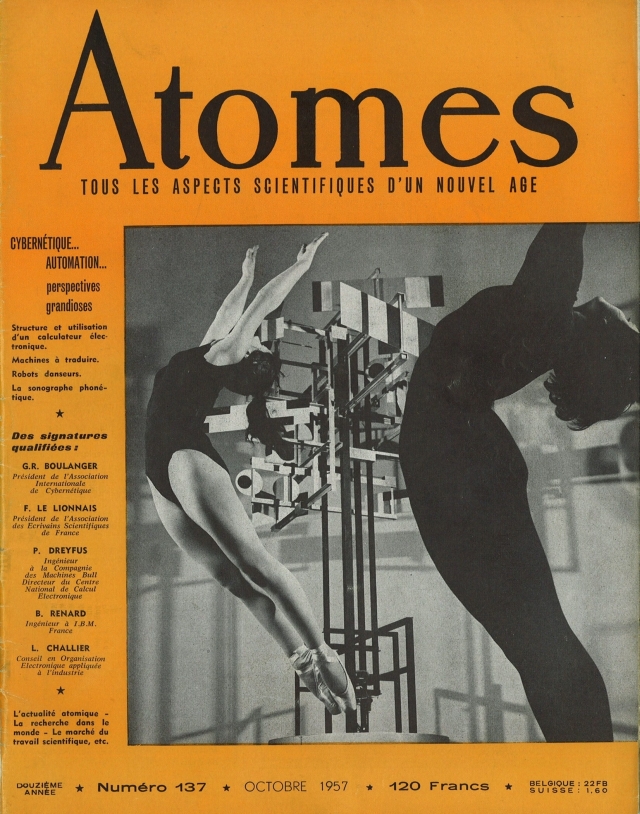
LA CYBERNETIQUE ET L'ART
Le Robot Danseur
Le sculpteur Nicolas Schöffer a réalisé cette composition spatiale en acier et duraluminium que l'on voit ci-contre et sur la couverture de ce numéro, à laquelle a été adjoint un cerveau électronique mis au point par la S. A. PHILIPS.
L'ensemble est fixé sur un socle monté sur quatre roulettes. Dans ce socle se trouvent le mécanisme et le cerveau électronique (photo ci-dessus).
CYSP-I (abréviation de CYbernétique, SPatiodynamique) est la première « sculpture spatiodynamique » dotée d'une autonomie totale de mouvement : déplacement dans tous les sens à deux vitesses, ainsi que rotation axiale et excentrique et animation de ses seize plaques polychromes pivotantes.
Chacune des plaques ou des ailettes montées sur la charpente est actionnée par un petit moteur placé sous son axe.
Des cellules photoélectriques et un microphone intégrés dans l'ensemble, captent toutes les variations intervenant sur le plan de la couleur, de l'intensité lumineuse et de l'intensité sonore.
L'ensemble de ces changements provoque des réactions de la sculpture consistant en des mouvements de déplacement et d'animation combinés. Par exemple, elle s'excite à la couleur bleue, c'est-à-dire qu'elle fait tourner rapidement ses plaques; elle se calme au rouge, mais en même temps elle s'exalte au silence et se calme au bruit. Elle s'excite aussi dans l'obscurité et s'apaise à la lumière intense.
Etant donné que ces phénomènes sont constamment variables, les réactions sont également toujours changeantes et imprévues, ce qui donne à l'ensemble une vie et une sensibilité quasi-organiques. Cependant, pour des raisons de sécurité, les déplacements de la sculpture sont téléguidés.
Le danseur-robot CYSP I a participé à différentes manifestations comme la « Nuit de la Poésie », au théâtre Sarah Bernhardt, le Festival de l'Art d'avant- garde sur la terrasse de la « Cité Radieuse » de Le Corbusier à Marseille.
Il pourra prendre place dans des spectacles cinématographiques. C'est ainsi qu'est prévue la réalisation d'un film abstrait utilisant tous les effets visuels qu'on peut obtenir, comme par exemple l'effet stroboscopique qui se produit quand ses plaques polychromes tournent à la vitesse des vibrations lumineuses, donnant ainsi un effet de mélanges colorés immatériels. Son ombre, projetée en mouvements, dédouble le spectacle.
Cet être artificiel est le prototype de toute une série d'autres sculptures spatiodynamiques qui, en groupe, pourront réaliser un grand spectacle cybernétique au sol et même dans les airs, créant ainsi une véritable synthèse entre les conceptions esthétiques les plus avancées et les moyens scientifiques les plus actuels, susceptibles de multiplier à l'infini leurs possibilités attractives.Translation:
CYBERNETICS AND THE ART
The Robot Dancer
The sculptor Nicolas Schöffer created this spatial composition of steel and duraluminium shown opposite and on the cover of this issue, to which was added a electronic brain developed by S. A. PHILIPS.
The assembly is mounted on a platform mounted on four wheels. In this base are the mechanism and the electronic brain (pictured above).
CYSP-I (abbreviation of Cybernetics, SPatiodynamique) is the first "sculpture spatiodynamique" with an autonomy of movement: Movement in all directions at two speeds, as well as axial and eccentric rotation and animation of its sixteen plates pivoting polychrome.
Each of the plates or fins mounted on the frame is actuated by a small motor under its axis.
Photoelectric cells and a microphone integrated into the whole, capture all the variations in terms of color, light intensity and the intensity of sound.
All these changes cause reactions sculpture consisting of travel movements and animation combined. For example, they get to the blue, ie it rotates rapidly on its plate, it calms down to red, but at the same time excited by silence and quiet noise. As they get in the dark and subsides to the light.
Since these phenomena are constant variables, the reactions are always changing and unforeseen, which gives a life and an almost organic sensibility. However, for security reasons, the movement of the sculpture are remote-controlled.
The dancer-robot CYSP I participated in various events like "Night of Poetry," Sarah Bernhardt at the theater, the Festival of avant-garde art on the terrace of the "City Radieuse" of Le Corbusier in Marseille .
It may take place in cinematic entertainment. Thus was laid the execution of an abstract film using all the visual effects that can be obtained, such as the stroboscopic effect that occurs when its polychrome plates rotate at the speed of light vibrations, thus a colorful mix of intangibles. His shadow, projected movement, doubling the performance.
This being artificial is the prototype of a whole series of other sculptures spatiodynamiques which group can make a big show cyber ground and even in the air, creating a true synthesis between aesthetic designs the most advanced and scientific the most current, likely to multiply in their infinite possibilities attractive.
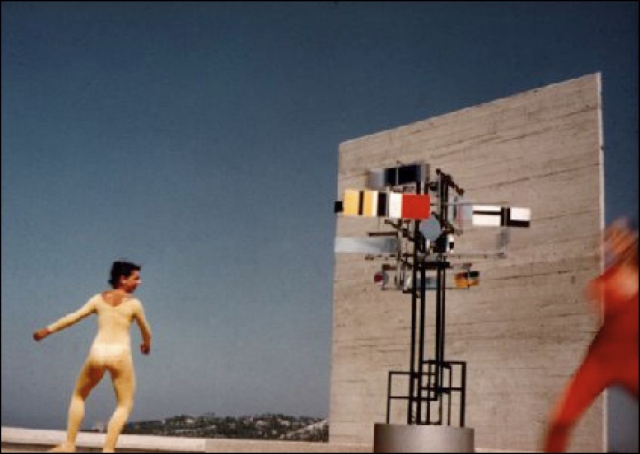
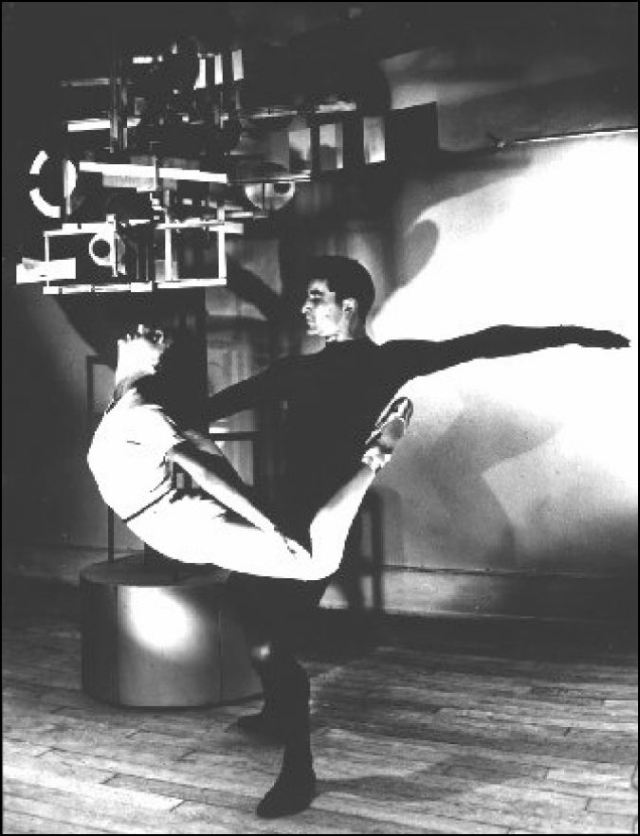
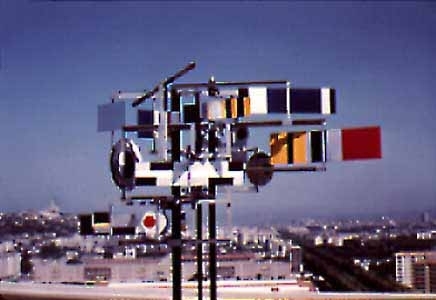
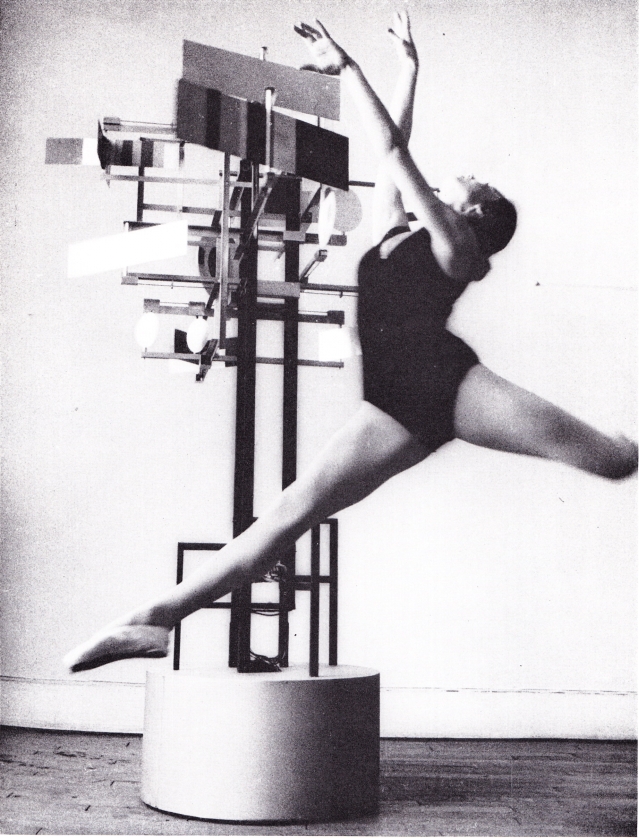
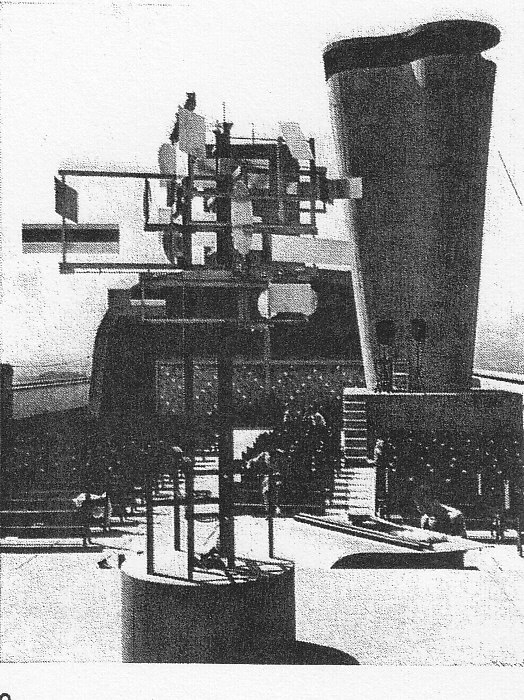
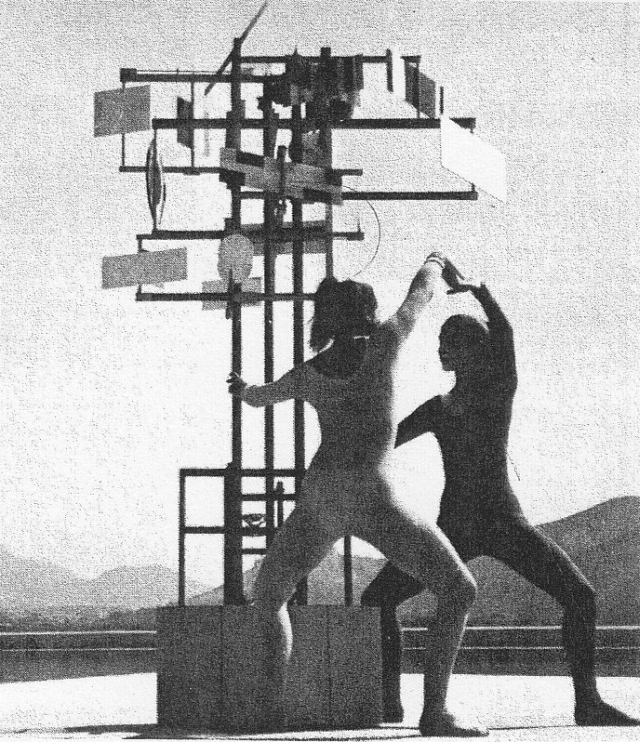
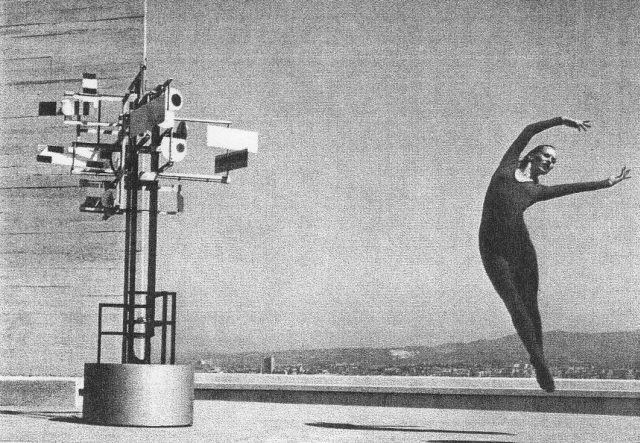
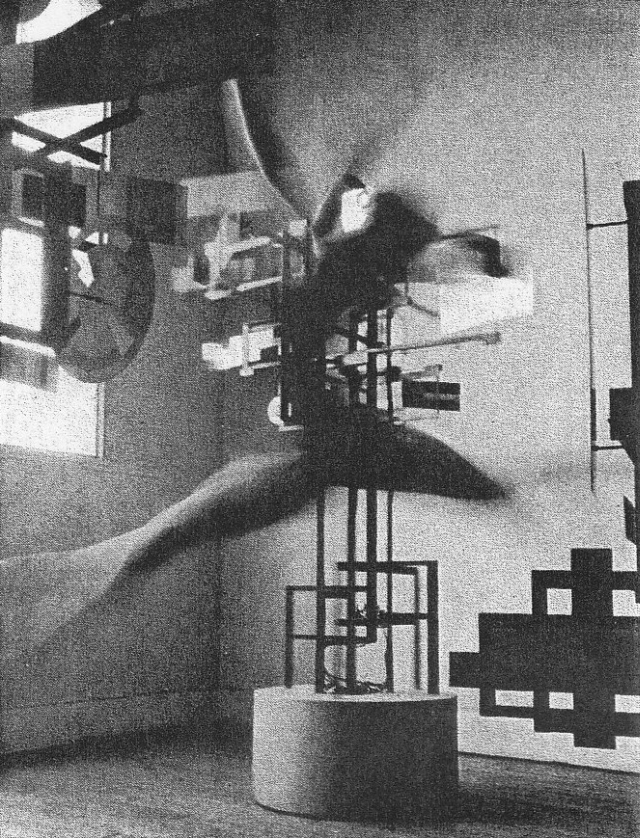
-x640.jpg)
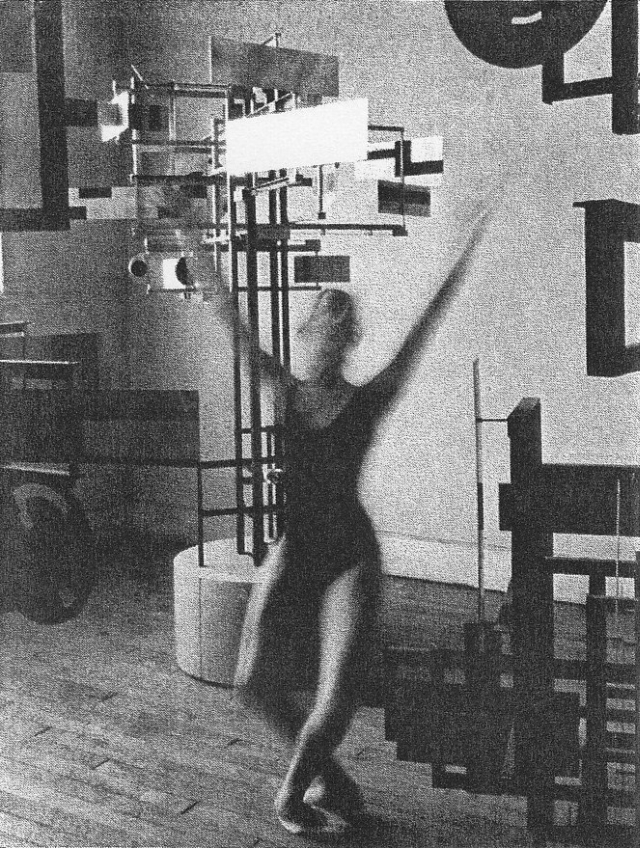
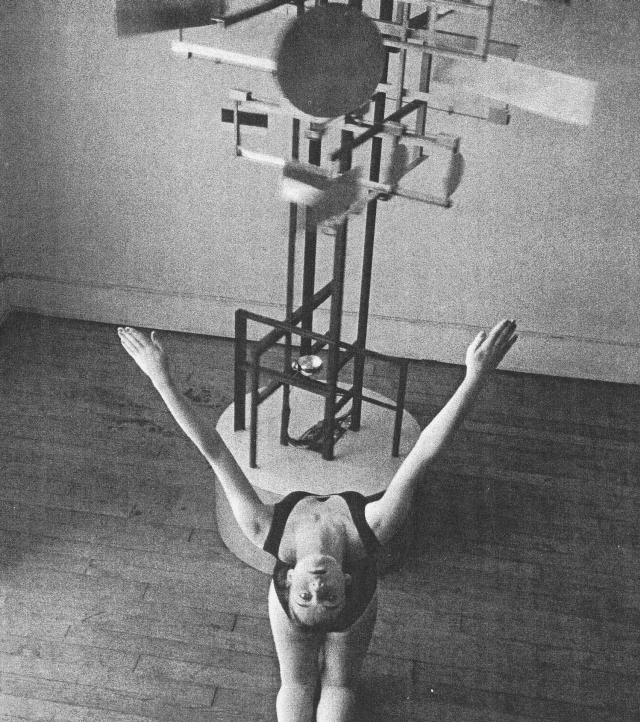
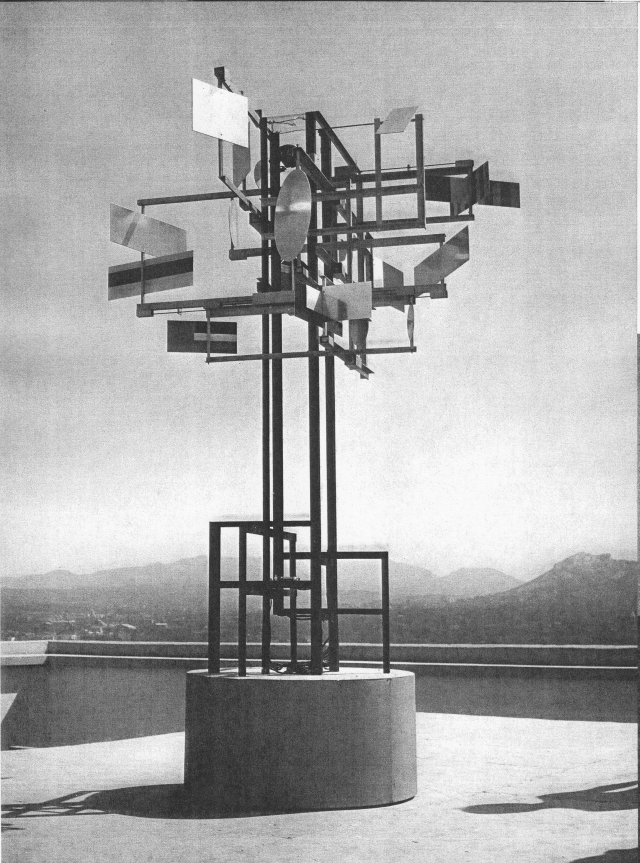
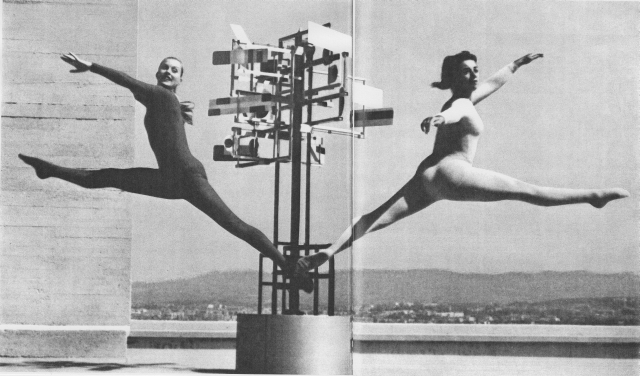
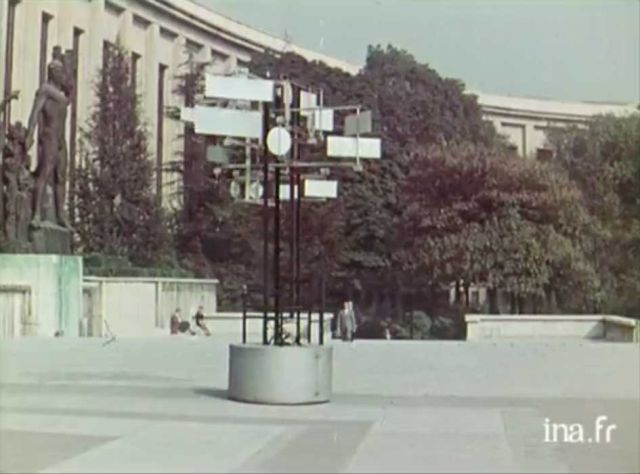

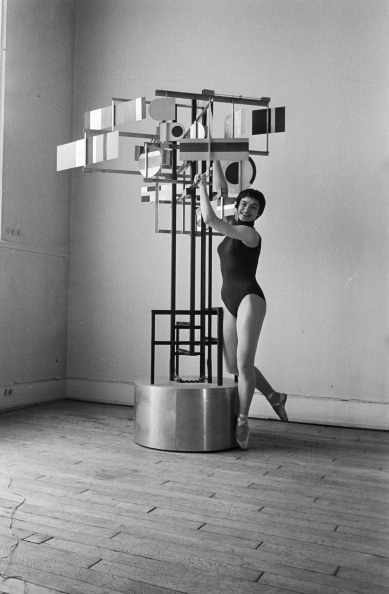
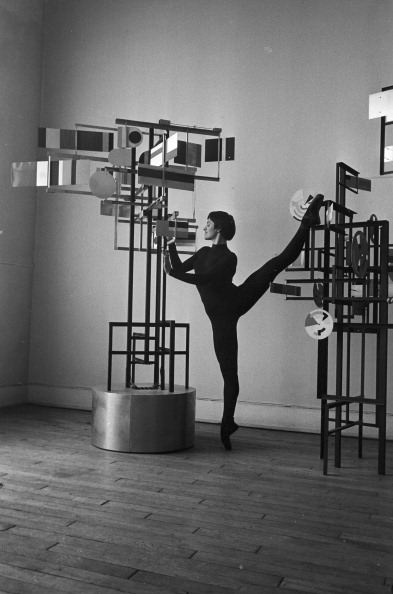
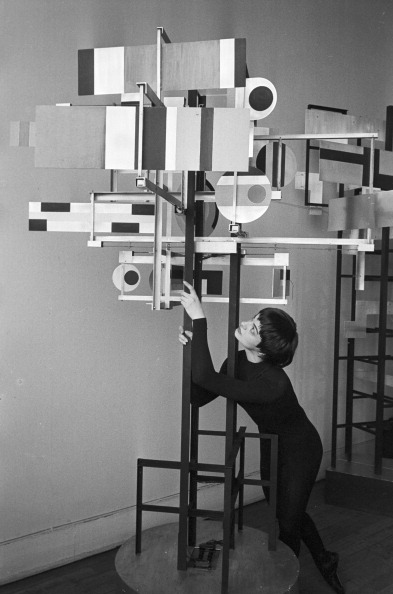

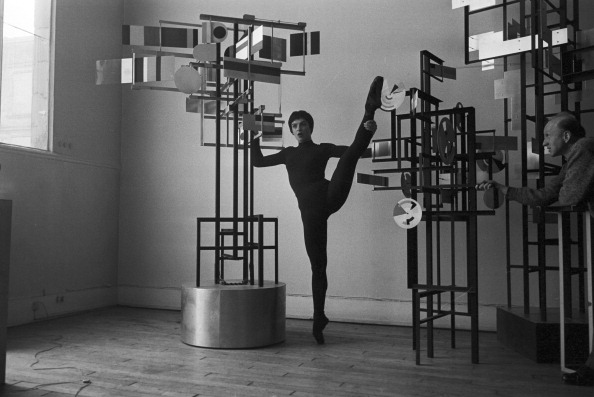
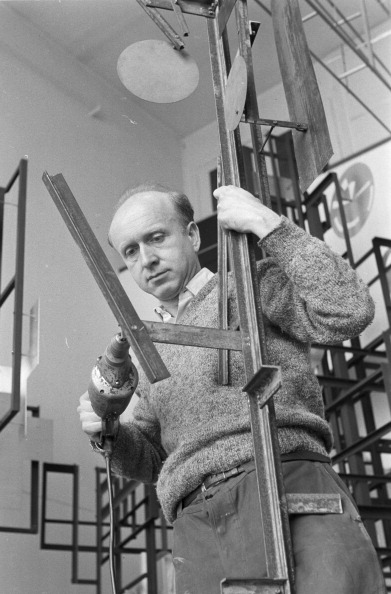
Valse à 120 volts (Article paru dans le magazine mensuel TOUT SAVOIR, septembre 1956)
VALSE A 120 VOLTS
Article paru dans le magazine mensuel TOUT SAVOIR de septembre 1956 (pages 37 à 39, 5 photos et 1 portrait)
suivi d'un commentaire d'Eléonore Schöffer.
L'ELECTRONIQUE, on le sait, envahit chaque jour des domaines où il eût paru invraisemblable qu'elle s'aventurât. Ainsi, le 12 juillet dernier, nous annonçait-on que l'automation avait, si l'on peut dire, mis la main sur la musique.
Mais oui : la Burroughs Corporation de Pasadena (Californie) a mis au point une machine qui, toute seule, compose des chansons ! Ainsi le "génie" contemporain a fignolé un cerveau électronique qui est capable de produire (sans essoufflement) mille mélodies populaires à l'heure, en recueillant des messages chiffrés et en les assemblant selon quelque schéma mélodique.
Vous vous dites sans doute qu'il s'agit là d'une sorte de record du monde dans le domaine, si fréquenté, de l'audace électronique.
Erreur. C'est nous, Français, qui possédons ce record du monde. Lisez bien…
Un socle cylindrique d'une quarantaine de centimètres de haut. Au-dessus, des barres métalliques plantées à la verticale. Et, s'échappant de ces barres, à hauteur d'homme, d'autres tiges, et des plaques de métal. De toutes formes, de toutes couleurs.
C'est un objet volumineux, une "chose" rigoureusement indéfinissable, sous quelque angle qu'on regarde. Cela ne ressemble à rien. Tout au plus peut-on songer à quelque combinaison de sémaphore, ou à un de ces objets insolites que les enfants construisent parfois avec les pièces de leur Meccano.
La bizarre construction s'appelle "Cysp1" . C'est une oeuvre d'art. Et aussi une machine. Une machine considérée comme une oeuvre d'art. En réalité, nous tenons là une sculpture cybernétique (la première qui existe au monde), que l'on dénomme également composition spatiale, en acier et duraluminium.
Il y a mieux. Cette sculpture, en effet, n'est pas immobile. Elle tourne, elle DANSE… Nous y voilà : Cysp1 est une danseuse. Une danseuse électronique.
Si, au lieu de rire, vous voulez bien réfléchir un instant, vous serez tenaillé par cette alternative : ou c'est prodigieux ou c'est l'oeuvre d'un fou singulièrement tourmenté par l'électronique…
Décrivons plus précisément l'engin. Sous le socle cylindrique, monté sur roulettes, se cache un mécanisme complexe et un cerveau électronique. Ceux-ci, par un assemblage d'axes, sont liés aux plaques de métal qui surmontent l'appareil. Disposées en un désordre apparemment total, on dénombre onze plaques rectangulaires et cinq en forme de disque. De dimensions diverses, elles sont toutes pivotantes et polychromes : rayures bleues et jaunes, bandes rouges, blanches et jaunes, etc… Chacune de ces plaques, est actionnée par un petit moteur, relié au cerveau caché dans le socle. Dans les recoins de l'infrastructure, sont logés des microphones et des cellules photo électriques, qui captent toutes les variations de couleur, d'intensité lumineuse et d'intensité sonore.
Là, nous touchons à l'essentiel. En effet, toutes les modifications de couleur et d'intensité affectent immédiatement l'étrange robot qui, aussitôt, entame quelque mouvement. La couleur bleue, par exemple, ou un son aigu, excitent Cysp1. Alors, la machine tourne de gauche à droite, agite ses plaques dans un sens donné, à une vitesse quelconque. Si, au contraire, vous proposez à Cysp1 une couleur rouge, une sonorité plus grave, une lumière vive, alors elle s'effraie, recule, tourbillonne sur elle-même, agite ses plaques dans un autre sens, à une autre vitesse… On devine le résultat : lorsque l'expérience se passe nuitamment, les plaques jettent frénétiquement des gifles multicolores sur les murs, comme un Kaléidoscope en folie, et l'échafaudage de tubes s'agite furieusement sur ses roues caoutchoutées.
Ces jeux apparemment incohérents de lumières et de mouvements sont réellement impressionnants d'étrangeté. Je n'y ai décelé, pour ma part, aucune beauté : Cysp1 ne m'a paru qu'un énorme jouet qui ne représente rien, et fait songer à cette fabuleuse machine si compliquée qu'un Américain fabriqua un jour… et qui ne servait strictement à rien ! …
Sculpture, électronique, ou l'une et l'autre?
A quoi répond donc cette création, géniale ou burlesque, selon les goûts ?
N. Schöffer, l'inventeur, le dit lui-même :
– Le spectacle figuratif a vécu. Et même l'art abstrait conventionnel.
Nous sommes dans une époque de rupture. Il faut suivre les précurseurs et je veux, moi, rompre avec la conception traditionnelle de la sculpture…
Nicolas Schöffer, précisons-le, est un artiste d'origine hongroise. Il a suivi les cours des Ecoles des Beaux-Arts de Budapest, puis de Paris.
– Quoi qu'on en dise, j'estime avoir subi une évolution très normale, un monde qui est de plus en plus accéléré.
N. Schöffer parle avec fougue et conviction. Front dégarni, yeux clairs, on pourrait le traiter de "prophète". Il se place, en tout cas, à l'extrême avant-garde.
C'est sans doute un visionnaire, jailli tout droit, peut-être, d'une tranche de science-fiction, d'art-fiction.
Cysp1, a-t-il dit, est une sculpture spatiodynamique. Qu'est-ce que…
– C'est en 1948 que j'ai découvert, créé le spatiodynamisme ; son but est l'intégration constructive et dynamique de l'espace dans l'oeuvre plastique. La sculpture spatiodynamique est créée d'abord par une ossature dont le rôle est de circonscrire et capter une fraction de l'espace en déterminant le rythme de l'oeuvre.
– Et alors ?…
– … Le spatiodynamisme doit bouleverser les concepts actuels de l'urbanisme. Il est logique que le dispositif d'ensemble soit conçu par le sculpteur, et non par l'architecte. Le "plastique" doit avoir le pas sur le "fonctionnel"…
– Mais votre robot-danseur ?…
– Le mouvement, la couleur et le son font partie de l'oeuvre et ils interviennent avec de constantes variantes grâce à l'électronique. La sculpture spatiodynamique est une sculpture-spectacle. Sa sonorisation est même possible en extrayant et utilisant des sons des différents éléments qui composent la sculpture…
Personnage hors série, Schöffer croit sincèrement, lui, à l'immense avenir de son insolite conception de la sculpture. Le 9 août dernier, en soirée, les Marseillais purent assister à cet évènement : Cysp1 dansa, dans la nuit trouée d'étoiles, en compagnie d'un couple de danseurs réputés, Michèle Seigneuret et Maurice Béjart, que ne rebute aucune audace. Pourtant accoutumés à la plaisanterie, les Marseillais furent médusés. Et hilares.
D'autant plus que ce gala ébouriffant se déroula sur la terrasse de la Cité Radieuse, que l'on sait être la "maison du fada" … Coïncidence fâcheuse, on en conviendra !
– Celui-là, peuchère, disait un spectateur en parlant de N. Schöffer, il a pris le soleil en plein sur la tête !…
Qu'on se moque de lui, le père du spatiodynamisme n'en a cure.
– Van Gogh était bizarre, lui aussi, à son époque…", me disait-il, l'autre jour.
J.-L. V.
N.B. On doit à la vérité de dire que sur le strict plan de la mécanique et de l'électronique, Cysp1 constitue une trouvaille assez extraordinaire.
Commentaire d'Eléonore Schöffer : Toute nouveauté scientifique ou technique est reçue avec crainte : la vitesse de 35 Km/h des premiers trains terrifiait, le coeur ne résisterait pas… Mais certains "osent" ! Quant à l'art, toute nouveauté fait rire : l'artiste est un "piqué".
Les "nouveautés" techniques et scientifiques se démodent et passent, remplacées par d'autres, plus performantes… Les nouveautés artistiques s'apprécient autrement avec le temps… L'impressionnisme… Van Gogh pour lequel se dépensent des sommes fabuleuses! L'art gagne en valeur avec le temps mais c'est aussi avec le temps que la société évolue suffisamment pour devenir capable de comprendre et d'aimer. L'artiste paraît "en avance" lorsqu'il est simplement en prise directe sur son temps, alors que c'est la plus grande partie de la société qui est en retard, agrippée qu'elle est à des habitudes et des valeurs dépassées, méfiante pour toute nouveauté, et paresseuse à s'adapter mentalement à des processus plus complexes.
Il faut pour tout chercheur de grandes qualités de force, de courage, de fidélité à soi-même pour résister aux sarcasmes, obtenir des décideurs leur confiance, et la possibilité de réaliser ce qui était "impensable"…
Ce fut le cas pour CYSP 1. Marcel JOLLY, alors directeur de Philips-France, raconte son hésitation devant la proposition ahurissante de ce jeune artiste :" et ce fut, dit-il, comme miser sur un cheval…!" Que ce décideur intrépide soit ici remercié de son pari courageux.VALSE A 120 VOLTS
Article published in the monthly magazine ALL KNOW September 1956 (pages 37 to 39, 5 photos and 1 portrait)
followed by a comment from Eléonore Schöffer.
ELECTRONICS, as we know, every day invades areas where it had seemed unlikely that she s'aventurât. Thus, on 12 July, we announced that we had automation, so to speak, put his hand on the music.
But yes, the Burroughs Corporation in Pasadena (California) has developed a machine which, itself, consists of songs! Thus the "genius" refined contemporary electronic brain that is capable of producing (without breath) one thousand melodies popular at the time, by collecting encrypted messages and assembling them according to some melodic pattern.
You say without doubt that this is a sort of world record in the field, if used, boldness mail.
Mistake. It is we, the French, who have the world record. Read …
A cylindrical base of about forty centimeters high. On top of metal bars planted vertically. And escaping from these bars, up to man, other rods, and metal plates. Of all shapes, all colors.
This is a large, a "thing" strictly indefinable in any angle you look. This is like nothing. At most, we can consider some combination of the semaphore, or one of those unusual objects that children sometimes build with the parts of Meccano.
The strange building called "Cysp1. It is a work of art. And also a machine. Machine considered a work of art. In fact, we would like is a cybernetic sculpture (the first that exists in the world), which is also called spatial composition, steel and duraluminium.
There are better. This sculpture, in fact, is not stationary. She turns, she danced … Here we go: Cysp1 is a dancer. A dancer electronics.
If, instead of laughing, you want to reflect for a moment, you will be plagued by this alternative: either it is or it is the prodigious work of a madman particularly troubled by the electronic …
Specifically describe the equipment. Under the cylindrical base, mounted on casters, lies a complex mechanism and an electronic brain. The latter, by an assembly of axes are related to metal plates that overcome the device. Arranged in a disorder apparently total, there are eleven and five rectangular plate-shaped disc. Different sizes, they are pivoting and polychrome: blue and yellow stripes, red stripes, white and yellow, etc … Each of these plaques is operated by a small motor connected to the brain hidden in the base. In the recesses of the infrastructure are housed microphone and photo electric cells, which capture all the variations of color, light intensity and loudness.
Here we touch on the essentials. Indeed, any changes in color and intensity affect immediately the strange robot, which immediately began some movement. The color blue, for example, or a sharp, excited Cysp1. So the computer is running from left to right, shakes his plates in a given direction at any speed. If, however, you propose to Cysp1 red, a more serious tone, a bright light, then it frightened, falling, swirling in on itself, shake his plate in another direction at another speed .. . One can guess the result: when the experiment is going on night, the cast plates multicolores frantically slaps on the walls, like a kaleidoscope in madness, and the scaffolding tubes agitated furiously on rubber wheels.
These apparently inconsistent play of light and movement is really impressive strangeness. I did detect, for my part, no beauty Cysp1 did published a huge toy that does nothing, and think about this fabulous machine so complicated that an American manufactured one day … and is used strictly for nothing …
Sculpture, electronic, or both?
What therefore this work, or brilliant burlesque to taste?
N. Schöffer, the inventor, himself says:
– The show has lived figurative. And even abstract art conventional.
We are in a time of rupture. We must follow the precursors and want me to break with the traditional concept of sculpture …
Nicolas Schöffer, get it, is an artist of Hungarian origin. He followed the course of the Ecoles des Beaux-Arts in Budapest, then Paris.
– Whatever you say, I have been a very normal, a world that is increasingly accelerated.
N. Schöffer speaks with enthusiasm and conviction. Front empty, clear eyes, you might deal with "prophet". It takes place in any case, in the extreme avant-garde.
It is without doubt a visionary, sprang straight, perhaps a slice of science fiction, art, fiction.
Cysp1, he said, is a sculpture spatiodynamique. What …
– In 1948 I discovered, spatiodynamisme created, its aim is the integration of dynamic and constructive space work in the plastic. Spatiodynamique sculpture was created by a first frame whose function is to contain and capture a fraction of space in determining the pace of the work.
– And then …
– … The spatiodynamisme must change existing concepts of town planning. It makes sense that the whole device is designed by the sculptor, not the architect. The "plastic" must take precedence over the "functional" …
– But your robot-dancer …
– The movement, color and sound are part of the work and they work with constant variations through the mail. Spatiodynamique sculpture is a sculpture show. His sound is possible by extracting and using sounds of different elements of the sculpture …
Occasional character, Schöffer believes him, the future of his immense unusual design of the sculpture. On 9 August last evening, the Marseillais able to attend this event: Cysp1 danced on the night of Star break, with a couple of famous dancers, Michèle Seigneuret and Maurice Béjart, that does not discourage boldness. Yet accustomed to the joke, the Marseillais were dumbfounded. And hilarious.
Especially since this ébouriffantes gala was held on the terrace of the Radieuse City, known to be the "house of the fada" … Unfortunate coincidence, you will agree!
– That man, peuchère, a spectator said in speaking of N. Schöffer he took the sun right on the head …
We make fun of him, the father of spatiodynamisme not a cure.
– Van Gogh was weird, too, in his time … "He said the other day.
J.-LV
NB It is the truth to say that the strict terms of mechanics and electronics, Cysp1 is a quite extraordinary find.
Commentary Eléonore Schöffer: Any scientific or technical novelty is received with fear: the speed of 35 km / h trains first terrified, the heart would not … But some "dare"! As for art, any novelty laugh: the artist is a "dive".
The "new" technical and scientific become outdated and are replaced by more efficient … The latest artistic appreciate over time otherwise … Impressionism … Van Gogh to spend which are fabulous! The art is gaining in value over time but also over time as society changes enough to become capable of understanding and love. The artist seems "ahead" when it is simply in direct its time, whereas most of the company that is late, it agrippée is in habits and values exceeded suspicious for novelty, and lazy to mentally adapt to more complex processes.
It is necessary for any researcher of great qualities of strength, courage, loyalty to oneself to resist sarcasm, makers get their confidence, and the feasibility of which was "unthinkable" …
This was the case for CYSP 1. Marcel JOLLY, then head of Philips France, says his reluctance to the proposal of this amazing young artist "and it was, he said, as betting on a horse …!" That this decision is fearless here thanked for his courageous gamble.
CYSP 1. Le danseur cybernétique (PHIL A PHIL, juin 1956)
CYSP 1 – Le danseur cybernétique
Extrait de la revue PHIL A PHIL de juin 1956
Au cours de la "Nuit de la Poésie", organisée le 28 mai au Théâtre Sarah-Bernhardt, un robot danseur électronique extraordinaire a été présenté par son créateur, le sculpteur Nicolas Schöffer. L'animation de cette composition abstraite avait été confiée à Philips. Cette réalisation d'un danseur animé marque le premier effort tendant à allier la sculpture abstraite et la chorégraphie. Nicolas Schöffer, qui, on s'en souvient, avait déjà conçu avec le concours de Philips un robot compositeur unique au monde avec la Tour Spatiodynamique Cybernétique et Sonore l'année dernière dans le parc de Saint-Cloud, lors de la première Exposition Internationale du Bâtiment et des Travaux Publics, a ainsi réalisé une composition métallique polychrome douée d'une totale autonomie de mouvements. Un cerveau électronique, étudié et mis au point par nos ingénieurs, lui donne la posibilité de se déplacer, de tourner sur elle-même et d'animer les seize éléments mobiles qu'elle porte, à diverses vitesses. Chacun des mouvements est déclenché par des signaux lumineux ou sonores, captés par des cellules photoélectriques et des microphones intégrés dans l'ensemble, ce qui donne à l'appareil une sensibilité quasi oganique. Le danseur cybernetique "CYSP I" se déplacera et s'animera suivant le déroulement du scénario lumineux et sonore conçu par le chorégraphe. C'est sur un accompagnement de musique concrète de Pierre Henry, que "CYSP I" a fait ses "premiers pas" dans le monde. Ultérieurement, il "dansera" dans la troupe de Maurice Béjart.
English translation (using Google translator)
CYSP 1 – The dancer cybernetics
Extract from the journal PHIL PHIL A June 1956
During the "Night of Poetry", held May 28 at the Théâtre Sarah Bernhardt, an electronic robot dancer extraordinaire, was introduced by its creator, the sculptor Nicolas Schöffer. The animation of abstract composition that had been given to Philips. This realization of a dancer animated marks the first effort to combine the abstract sculpture and choreography. Nicolas Schöffer, which we remember, had already developed with the assistance of a robot Philips composer in the world with Tower Spatiodynamique Cybernetics and Sound last year in the Parc de Saint-Cloud, at the first International Exhibition Building and Public Works, has achieved a good polychrome metal composition of full autonomy movements. An electronic brain, studied and developed by our engineers, gives the possibility to move, to turn on itself and lead the sixteen moving it relates to various speeds. Each movement is triggered by light or sound signals, captured by photocells and microphone integrated into the whole, giving the device a sensitivity almost organism. The dancer cybernetics "CYSP I" will move and will liven the course of the following scenario sound and lighting designed by the choreographer. On accompanying music concrete of Pierre Henry, that "I CYSP" was his "first steps" in the world. Subsequently, it "dances" in the troupe of Maurice Béjart.
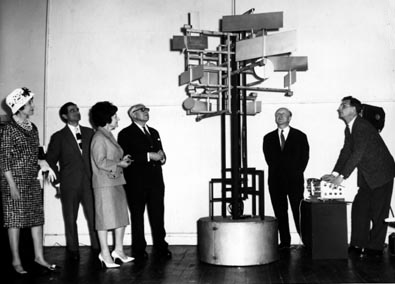
CYSP-1 at the ICA (above and below). Note the Antenna on CYSP-1 and the separate radio-control unit. See video clip here of Swedish exhibition showing the radio-control unit. (You will have to register and login to MovieTone before you can view this).
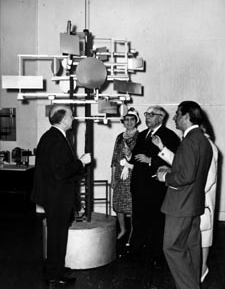

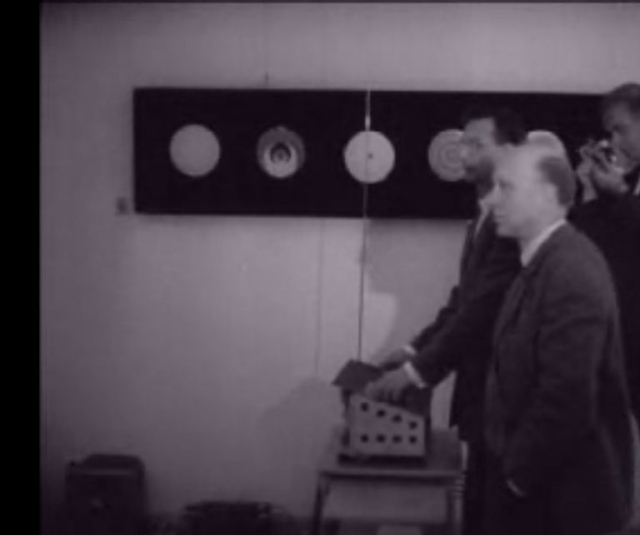
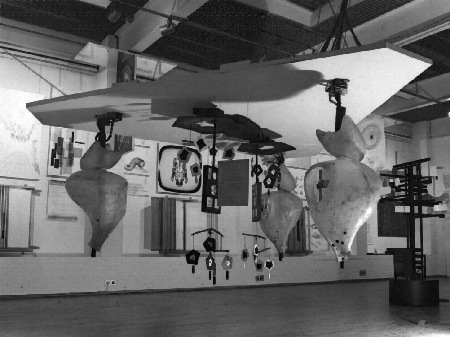
Cysp-1 on the right, with Gordon Pask's Colloquy at ICA's Cybernetic Serendipity, 1968.
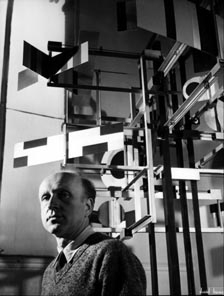

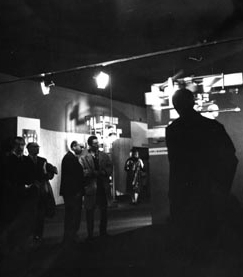

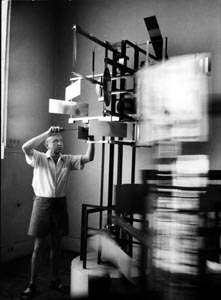
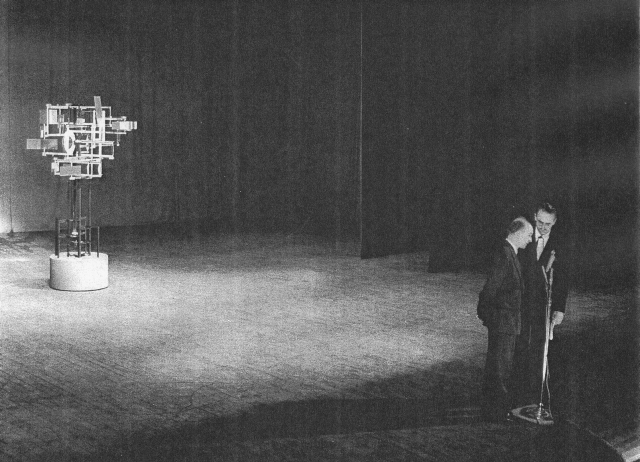

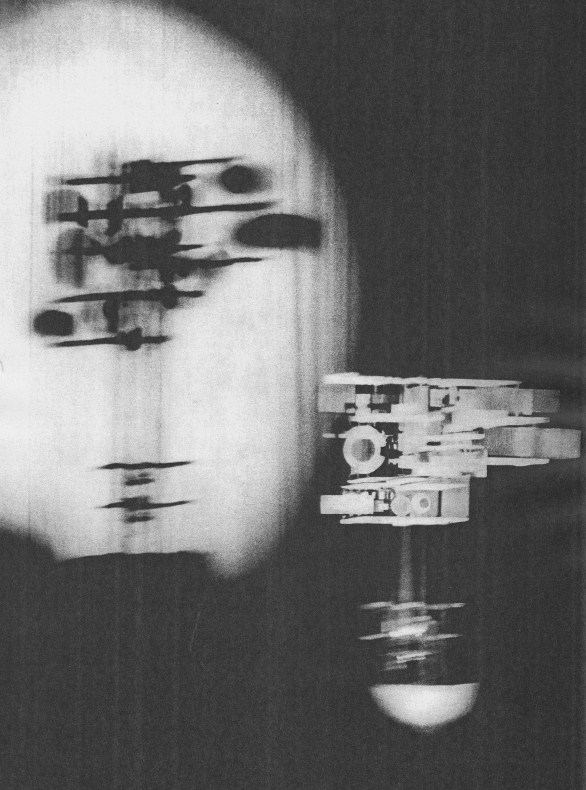
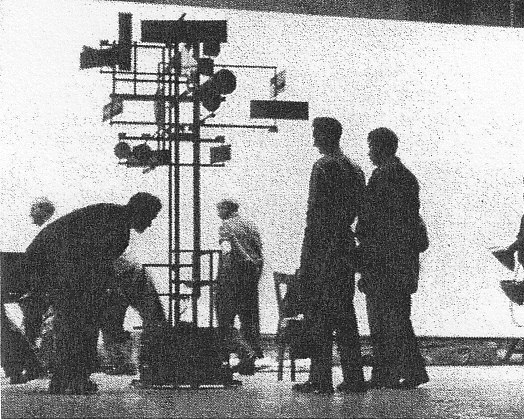
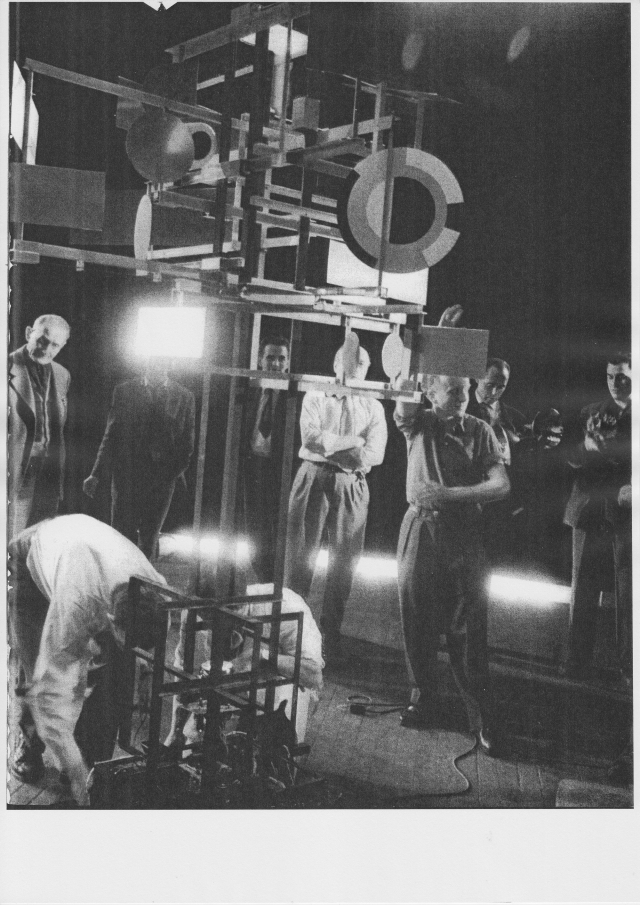
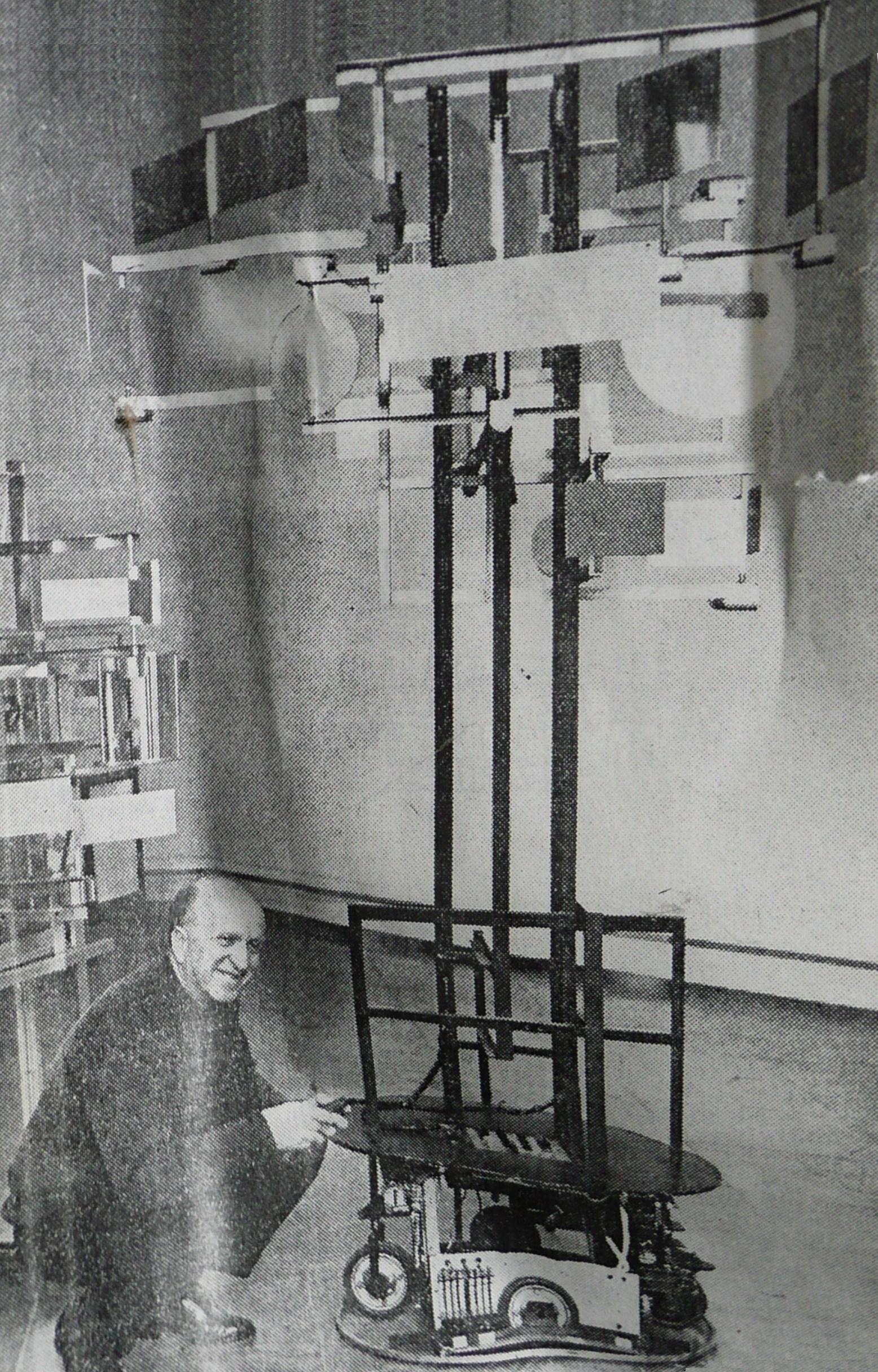
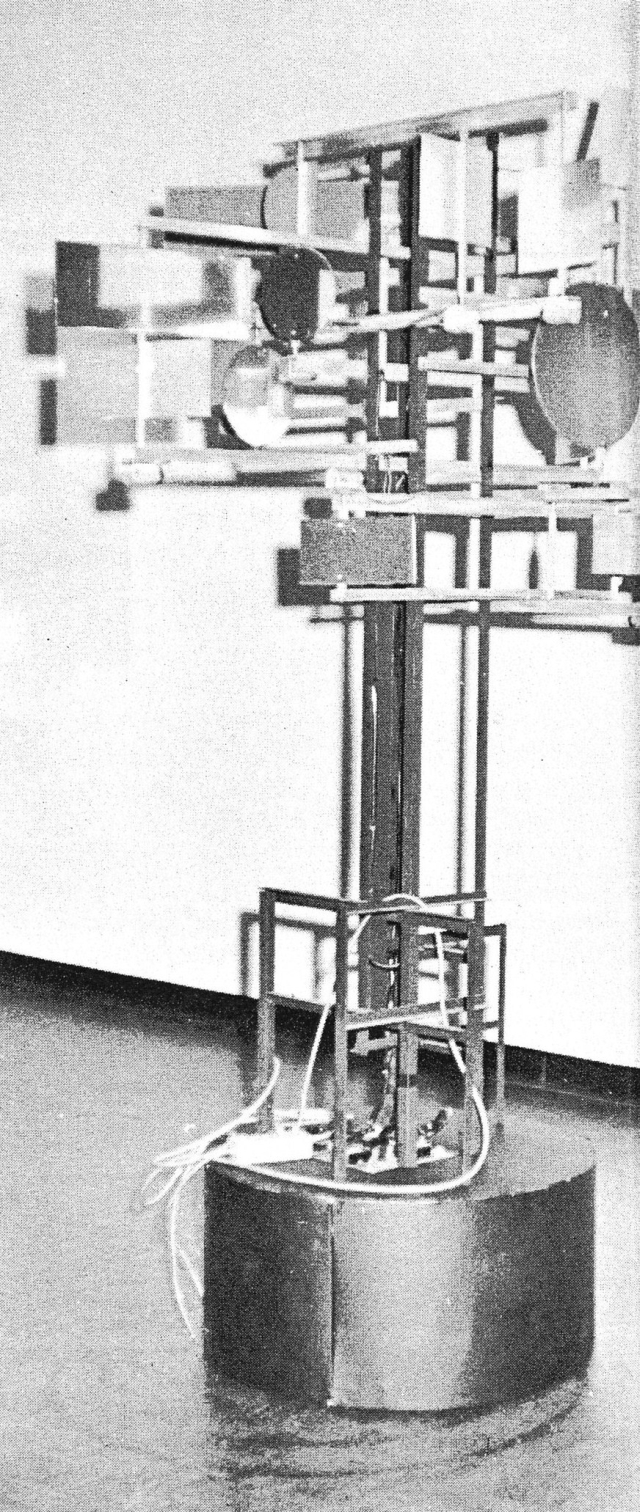
Electronic Design, Vol. 14, No. 1 – January 4, 1966
NEWS : Electronic pop-art art pops on the scene – p42
Roger Kenneth Field, News Editor
During the past month, exhibits of electronic art have blossomed in New York with a frequency that suggests an aesthetic explosion in electronics or, at the very least, an electronic explosion in aesthetics.
The word art is used advisedly. The creators of the works shown here do not represent these to be art in the classic sense. Not a single piece is fashioned of traditional material, nor with ordinary tools. In this new art, wire and junk iron replace marble and canvas; the welding torch and the screwdriver eliminate the -chisel and the paintbrush.
All of the works move and most of them make funny noises. In theory, there is no reason why art objects shouldn't make noise, yet when the clatter of the other art completely drowns out the one you're trying to listen to, you quickly develop a respect for quiet museums. The creators of these contraptions may or may not be competent artists, (history must decide that), but they certainly have senses of humor.
Marshall McLuhan, Canadian philosopher, observes that modern art is always one technology behind life. This is amply illustrated by these electronic efforts in our nuclear age. But Oscar Wilde said, "Life imitates art" and, indeed, there are pop-art people who bend every effort to look like the chap in the bottom photo on this page [not shown here].
……………………..
A more finished product was executed by Nicolas Schoffer, a Parisian visionary and city-planner, as well as artist. In his plan for a "cybernetic city," robots like his Cysp I (see photo above) can be summoned by pocket transmitter to perform a little spectacle anywhere.Design shortcomings are common to the other artists as well. Schoffer's Cysp 1 has a rear swivel wheel which jams because it has no caster. ………………
Admittedly, these efforts merely represent a start. Whether the path will really ever be run or whether electronics artists will fade, as did the fist and shoulder pianists, is hard to predict.
Certainly these examples in no way approach the present "state-of-the art." Perhaps a flurry of artistic activity among electronics design engineers will contribute to the culture as well as the technology of future generations.
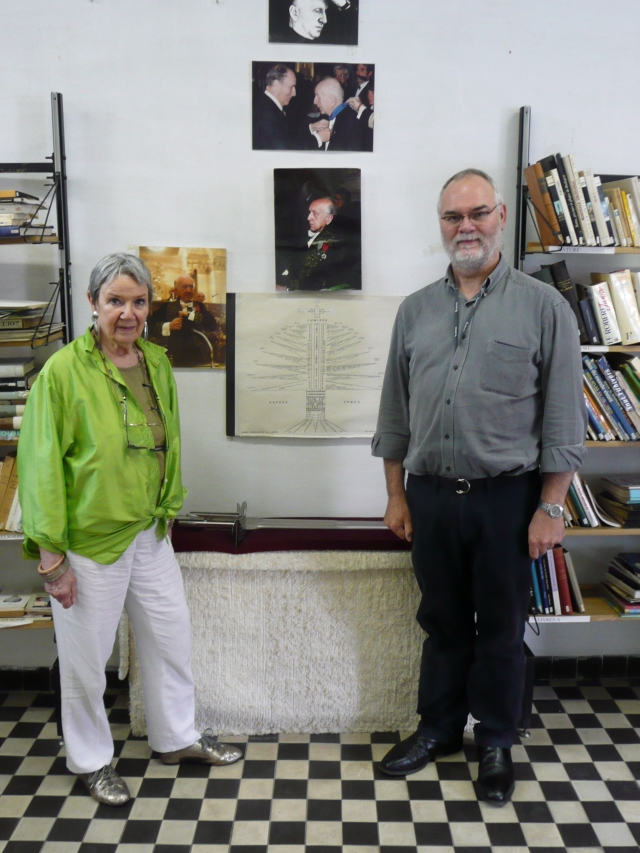
The author with Eléonore Schöffer de Lavandeya at the Schöffer Museum, Kalosca, Hungary, June 2009.
See the site dedicated to Nicolas Schöffer here.
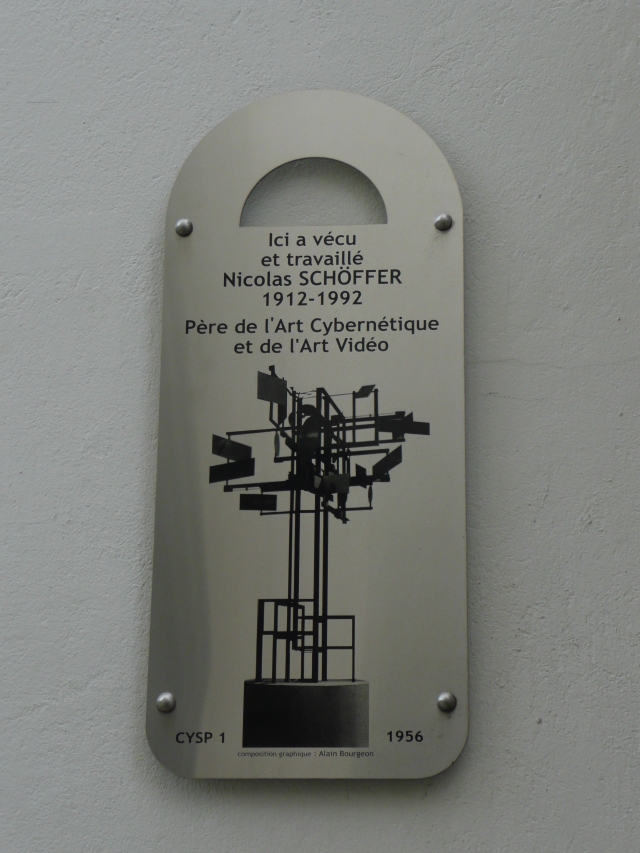
Plaque on wall of Schöffer's Atelier in Paris.
VIDEO CLIPS are found here and here (see below). You will have to register and login to MovieTone before you can view the first video clip.
LUMINO-DYNAMICS
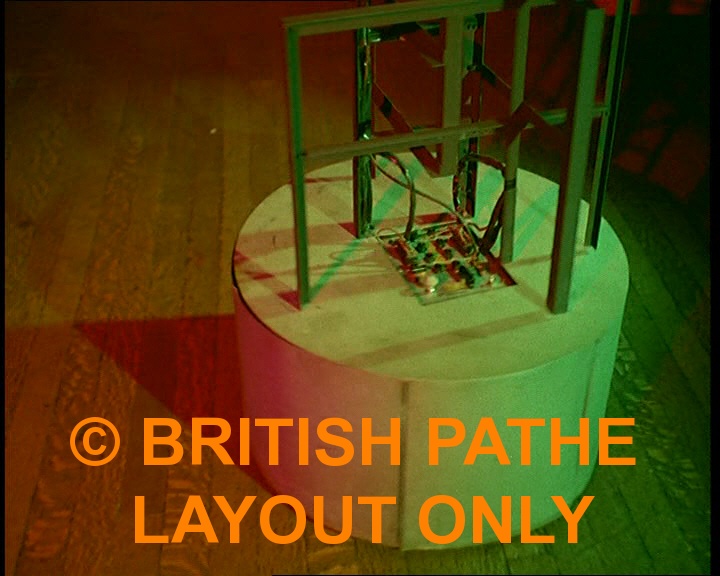

J'ai eté colaborateur de Monsieur Nicolas Schòffer & Monsieur André Devalet dans la decade 1970-1980 pour des diverses projects d'Architecture Cybernetique ainsi que des Plans de Developpement Urbanistiques d'avant-garde. Godofredo Salazar Reyes, Architecte Mexicain.
Je tiens a vous signaler que Monsieur Nicolas Schôffer & André Devalet sont les premiers artistes-createurs en France qu'ont apporté son savoir-faire a l'art cybernetique et a l'architecture prospective en Europe. Il faut lire ses livres sur le sujet. Godofredo Salazar Reyes. Architecte Mexicain
Une très belle presentation sur le travail de Monsieur Nicolas Schôffer; il faut souligner aussi qu'il a eté un visionaire de l'Urbanisme et de L'Architecture moderne dans le monde entier.
Tres bon sujet , merci